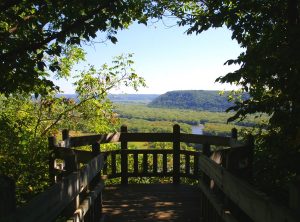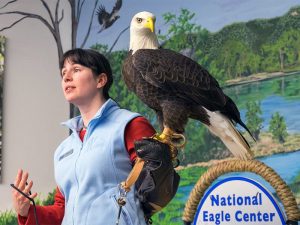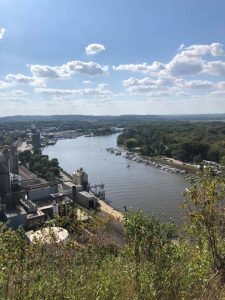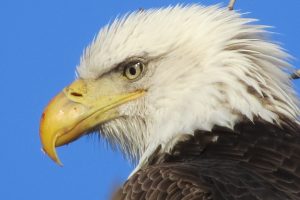Get ready to go outside as you explore the Mississippi River and its surroundings. There are great opportunities for outdoor recreation up and down the Great River Road in spring, from hiking and biking to birdwatching and paddling—here’s where to go.
Hiking
There are lots of places to enjoy a scenic stroll along the Mississippi River in the spring or find a more challenging hike with stunning overlooks that make the hike worth the challenge. On the northern half of the Great River Road (through Minnesota, Wisconsin, Iowa, and Illinois, and into Missouri), many cities and towns along the river are home to scenic local and state parks that offer outstanding hiking opportunities along the limestone bluffs overlook the Mississippi River. The flatter terrain on the southern half of the river is no less impressive, as places like Mississippi’s Yazoo National Wildlife Refuge and Louisiana’s Barataria Preserve offer outstanding scenic walks as well.
Where to go: Pike’s Peak State Park (McGregor, Iowa); Mississippi River State Park (Marianna, Arkansas); Columbus-Belmont State Park (Columbus, Kentucky)
Biking
Explore the scenery of the Great River Road and the Mississippi River region on two wheels. Many cities along the route—Minneapolis and Saint Paul in Minnesota, the Quad Cities of Illinois and Iowa, and St. Louis, just to name a few—offer scenic paved bike trails alongside the river, and local and state parks up and down the Great River Road provide mountain bike trails for more adventurous pursuits.
Where to go: Quincy Riverfront Trail (Quincy, Illinois); Mississippi River Levee Bike Path (Baton Rouge, Louisiana); St. Louis Riverfront Trail (St. Louis, Missouri)
Birdwatching
The Great River Road is a perfect place for avid and amateur birdwatchers alike, as the Mississippi River Flyway is the migration route followed by 40 percent of all waterfowl and shorebirds in North America. Spring is a particularly good time to catch migrating birds, as songbirds like warblers, gnatcatchers, and vireos head back north after the winter and swallows, swifts, and migratory woodpeckers return to the bluffs and forests along the Mississippi River
Where to go: Reelfoot Lake State Park, Tiptonville, Tennessee; Upper Mississippi River National Wildlife and Fish Refuge Visitors Center, Onalaska, Wisconsin
Paddling
Want to get off the Great River Road and onto the actual Mississippi River? There are plenty of places to do so in the 10 states along the Great River Road, including serene backwaters, massive lakes, and the main channel of the mighty Mississipp’ itself.
Where to go: Mississippi River State Water Trail, Minnesota; Quapaw Canoe Company, Vicksburg, Mississippi
(Photo: Kayaking in Mississippi River State Park, Marianna, Arkansas/Arkansas Department of Parks, Heritage & Tourism)













